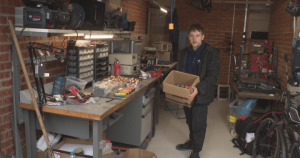Why companies must avoid the status quo trap

Unlock the Editor’s Digest for free
Roula Khalaf, Editor of the FT, selects her favourite stories in this weekly newsletter.
The writer is the author of ‘Uncharted: How to Navigate the Future’
Years ago, when I ran tech start-ups, I met senior Disney executives to discuss the streaming technology our business was developing. Their politeness failed them quickly. I needed to understand, they insisted, that their precious creative assets were the work of geniuses whose artistry I could never appreciate.
They would never deign to allow their masterpieces on to the philistine internet. Like many in their industry, they later spent years trying to catch up.
These wealthy, successful executives were up to their necks in the status quo trap: with everything going so well, they saw no need to change. It’s a common phenomenon.

When Netscape went public in 1995, Microsoft didn’t have a web browser in development. Google’s only serious foray into social networking came with Google+ in 2010, fully three years after Facebook was launched and too late to thrive. Kodak and Intel have since become legendary exemplars of a failure to adapt. Even a cursory survey of today’s business environment suggests a widespread failure to learn.
I remain aghast at the wilful blindness of companies with no decarbonisation strategy, no carbon budgets for staff, or even any recognition that they have a carbon footprint.
Similarly, as executives rush to claim mastery in artificial intelligence, it’s hard to find a single business with a coherent strategy for upskilling its workforce. Instead of debating the number of jobs potentially lost to the fast-evolving technology, they could develop new capability in their best, most loyal employees, knowing that smart people will seize the initiative if employers don’t. Instead, paralysis is common.
But not everywhere. Companies alert to the status quo trap can escape it. 3M was, for years, famed for its apparent ability to innovate fast. The more prosaic reality was that it was experimenting all the time. Many of these attempts at innovation went nowhere. But, instead of burying failures, these were analysed to identify what change in market conditions might make them flourish. When conditions shifted, old flops frequently became speedy successes.
What 3M does in innovation, the energy business SSE does with projects: identifying critical emerging trends and making big bets early. Strategy director Sam Peacock says that pursuing a number of potential new technologies provides strategic flexibility.
In 2012, a huge investment at Greater Gabbard was, for years, the largest offshore wind farm in the world. That joint venture with RWE Renewables enabled SSE to gain expertise early. This was expensive in the short term but helped the company scale fast when prices began to fall. Today, SSE’s project portfolio includes carbon capture and hydrogen.
“When we see the strategic alignment,” says Peacock, “we are not afraid to go after it. You develop the relationships, the expertise and the supply chain to move fast when the time is right.”
There’s a subtle judgment, he says, between going too early into energy transition (Ørsted) and going late (the oil majors). He calls SSE’s a “1.2 strategy” and emphasises the human capital it builds. “Once you start moving, people want to work for you to be part of it,” he says. “You attract knowledgeable and ambitious people and build a centre of gravity.”
In my experience, it’s rare that employees don’t spot trends early, wondering why their management doesn’t take action. Calling on collective insight can both identify and motivate change.
When Pixar executives spotted that their movies were becoming more expensive and taking longer, thus threatening the company’s ethos of daring and innovation, they might have launched into conventional cost-cutting. Instead, they proactively engaged the entire workforce in identifying changes across all company processes that achieved more than the leadership team had imagined. And nobody had to sell change to the people who had designed it.
All of which demonstrates that the status quo trap is not inevitable. So why don’t more companies emulate the bold over the passive? Incrementalism might promise the high degree of certainty that some chief executives and investors crave. But it can’t deliver the levels of initiative and ambition required to overcome challenges that, like the climate, water, food and inequality crises, won’t go away.
Many so-called leaders expend more energy seeking alibis — timid investors, an uncreative workforce — than ideas. Others are tethered to entrenched mental models that block imaginative thinking. Executive teams frequently demand complete information before daring to change, blind to the fact that, by the time it arrives, they are already behind.
They should take to heart the theme of the great Italian novel, The Leopard: for things to stay the same, everything has to change.
#companies #avoid #status #quo #trap




